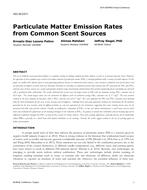Description
The use of artificial scent generation products is a popular strategy to mitigate unpleasant odors indoors, as well as to generate pleasant scents. However, the operation of these products may result in the indoor emission of particulate matter (PM), a harmful pollutant with a variety of health impacts. In this paper, we studied three distinct types of scent generating products: incense (a combustion-based source), a wax warmer (a flameless heat-based source) and an ultrasonic oil diffuser (a device that uses ultrasonic vibrations to aerosolize an emulsion of water and essential oils). We measured the PM1 and PM2.5emission rates of these sources in a sealed experimental chamber using concentration obtained from three particle monitoring devices (including one corrected with a gravimetric filter calibration). The results indicated that incense was the largest source of PM, with an estimated average PM2.5 emission rate of 42.9 mgh-1. The second largest source was the ultrasonic oil diffuser, with an estimated average PM2.5 emission rate of 1.7 mgh-1. The wax warmer resulted in the least amounts of emissions, with a PM2.5 emission rate of 0.17 mgh-1. We also compared the PM1 and PM2.5 emission rates obtainedfrom the three instruments for the cases of wax warmer and oil diffusers. Although there were good agreements between the instruments for the particles generated by the wax warmer, with oil diffuser particles we saw less agreement for one instrument suggesting that some scenting sources may not be measured well with some particle counters. Finally, we performed a simulation of PM2.5 in two real indoor environments: a small room and an entire house and evaluated the effectiveness of air cleaning techniques in the reduction of PM2.5. In general, we found that ventilation and air cleaning may not be sufficient to effectively mitigate the PM2.5 of some of these sources in certain contexts. These three scenting approaches, especially incense, led to considerable indoor PM2.5, especially in a small room with limited ventilation or air cleaning. Overall, the results suggest caution in the use of scenting agents inindoor environments.
Citation: 2018 Annual Conference, Houston, TX, Conference Papers
Product Details
- Published:
- 2018
- Number of Pages:
- 10
- Units of Measure:
- Dual
- File Size:
- 1 file , 1.1 MB
- Product Code(s):
- D-HO-18-C011




